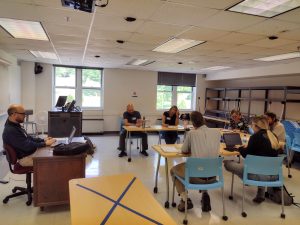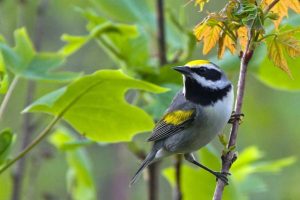Perhaps more than any other of AMJV’s focal landscapes, the Greenbrier and High Alleghenies Focal Landscape in eastern West Virginia highlights the important connections between the conservation and management of upland, aquatic, and even subterranean systems in a healthy and productive ecosystem. In addition to large blocks of forest hosting AMJV priority species such as Wood Thrush and Cerulean Warbler, the focal landscape has valuable aquatic resources such as the Greenbrier River, the longest undammed river in the Central Appalachians. According to the West Virginia State Wildlife Action Plan, the focal landscape hosts many rare aquatic species, including the regionally endemic New River Crayfish and Upland Burrowing Crayfish, Eastern Hellbender, and the federally-listed Virginia Spiraea and Candy Darter. Most notably, the focal landscape region is a globally significant karst landscape with more caves occurring in this region than anywhere else in West Virginia. Rare cave species in the region include the Greenbrier Valley Cave Pseudoscorpion, Organ Cave Pseudoscorpion, Greenbrier Cave Amphipod, and the world’s only known population of West Virginia Spring Salamander.
Conserving a region with such a diversity of habitats and priority species requires engaging a diversity of local stakeholders in our work. To help with this process, the West Virginia State Wildlife Action Plan identifies specific regions called Conservation Focus Areas (CFAs) where Species of Greatest Conservation Need (SGCN) are concentrated, addressable threats are identified, and opportunities exist for focused actions. The AMJV focal landscape overlaps the Great Greenbrier and High Alleghenies CFAs. Last year, West Virginia Division of Wildlife Resources (WVDNR) and The Nature Conservancy worked with local stakeholders to develop plans for these CFAs targeting priority species with specific actions at a local level (available to view at: https://wvdnr.gov/state-wildlife-action-plan/).

Breakout group discussing capacity gaps at a stakeholder meeting held in Lewisburg.
AMJV assisted WV DNR with the planning and facilitation of two stakeholder meetings for partners in the Greenbrier and Alleghenies Focal Landscape in June 2022. The goal of the meetings was to establish a foundation for collaboration among stakeholders to implement, monitor, and evaluate the results of conservation actions outlined in Conservation Focus Area plans that have been developed by WV DNR as part of their State Wildlife Action Plan process. The meetings were attended by representatives from more than a dozen organizations, including NRCS, US Fish and Wildlife Service, and US Forest Service. Through breakout sessions and group discussions, the meeting attendees identified and prioritized the conservation actions from the CFA plan with the greatest capacity gaps. AMJV staff are exploring the needs for each prioritized action and to find opportunities to address these needs by collaborating with local stakeholders.
Priority Conservation Actions
Private Landowner Engagement
To build the capacity for private lands conservation in West Virginia, AMJV and WVDNR have partnered with USDA Natural Resources Conservation Service (USDA-NRCS) to support the hiring of partner biologists stationed across the state, including pollinator specialists, avian biologists, and foresters. These partner biologists have helped enroll private landowners into Farm Bill funding opportunities to improve forest habitat across the state for pollinators, Cerulean Warbler, and Golden-winged Warbler. Significant growth in acres managed has been seen since the program’s inception. The initiatives have contracted 1,568 acres of private lands to improve young forest habitat for Golden-winged Warbler and 1,989 acres of private lands to improve mature forest habitat for Cerulean Warbler. While pollinators frequently benefit from the habitat work in each of these projects, the pollinator specialists have additionally contracted 226 acres to create pollinator plantings on private lands across the state.

Golden-winged Warbler. Courtesy of Rob Dickerson/Macaulay Library at the Cornell Lab of Ornithology
The addition of Liz Brewer to AMJV’s staff as our Outreach Specialist based in West Virginia has greatly expanded our capacity to provide resources to land managers, foresters, and landowners managing forests to benefit birds and other wildlife. One example is the creation of a virtual field tour of “Creating Young Forests” that focuses on management practices and cost share opportunities that private landowners across West Virginia can implement to create or improve habitat for Golden-winged Warbler on their land. The virtual field tour visits private landowners with active and completed projects managing for Golden-winged Warbler habitat in West Virginia. The tour shows images of managed areas that allow viewers to see the results of different management practices on the ground and how they benefit forest health and wildlife.
Developing New Resources to Support Forest Management for Birds
AMJV staff is collaborating with WV DNR to update and re-design “West Virginia Forest Songbird Management Guidelines”, a guide which was orginially published in 2006. An initial meeting was held to discuss the need to update the document, and it was decided that a new version of the document would be valuable and should be developed. A draft outline for the new guide has been completed and is currently being reviewed by local agency and consulting foresters.
Additionally, as part of a project led by the Forest Stewards Guild, AMJV is assisting with the development of a forest management plan template for use throughout Central Appalachia. The plan template will meet NRCS standards and incorporate management guidelines for the three indicator bird species that are the focus of the Central Apps program (GWWA, CERW, and WOTH). The template will scale landscape-level mosaic management for public, NGO, or private family forestland owners and practitioners to increase habitat connectivity for the species, and will be available for use by practitioners within and beyond West Virginia.
West Virginia Division of Natural Resources is the lead partner for this focal landscape. Other partners include:
WV Division of Forestry
National Wild Turkey Federation
The Nature Conservancy
West Virginia USDA-Natural Resources Conservation Service
Forest Stewards Guild
Weyerhaeuser
Sustainable Forestry Initiative
West Virginia University
Wildlife Management Institute
Central Appalachian Spruce Restoration Initiative
U.S. Fish and Wildlife Service
U.S. Forest Service
Office of Surface Mining, Reclamation, and Enforcement
American Forest Foundation
U.S. Geological Survey
Ruffed Grouse Society